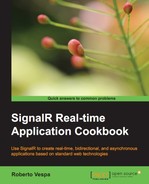SignalR offers a couple of ways to exclude entire sets of connections from a broadcast; here, we see how we can exclude a specific set of connected clients using their ConnectionId properties.
To demonstrate this feature, we need a slightly more complex sample. Let's consider a case where some of the messages should go unobserved by the specific clients we do not want to target. In such a case, we would need to inform everybody about who else is connected, and provide a way to pick some of those in order to exclude them from the next broadcast. To achieve this, we store a list of all the received connections in a static Hashset member inside the hub, and we send this set to every connected client when it calls a Subscribe() method. This set of connections will be used by the client to show a list of identifiers from which the user can select who to exclude when performing the broadcast of the message. To keep the UI simple, we'll let the user exclude just one recipient; however, the code can be easily extended to exclude several of them.
In order to write the code of this recipe, we need to create a new empty web application, which we'll call Recipe11.
Let's prepare the ground by performing the following steps:
- We add a Hub called
EchoHub. - We then need the OWIN Startup bootstrap class. We name it
Startupand add theConfiguration()method to it, containing a call toapp.MapSignalR();. - The Hub should contain the following code:
using System; using System.Collections.Generic; using System.Linq; using Microsoft.AspNet.SignalR; using Microsoft.AspNet.SignalR.Hubs; namespace Recipe11 { [HubName("echo")] public class EchoHub : Hub { static readonly HashSet<string> connectionIds = new HashSet<string>(); public void Subscribe() { var connectionId = Context.ConnectionId; connectionIds.UnionWith( new [] { connectionId }); Clients.All.connections(connectionIds); } public void HelloBut(string excludeConnectionId) { var msg = string.Format("Welcome {0} at {1:F}!", Context.ConnectionId, DateTime.Now); var allExcept = Clients.AllExcept(excludeConnectionId); allExcept.greetings(msg); } } }
What's important here? We need to make sure that we perform the following steps:
- The class contains a static
Hashsetmember to keep a unique list of all the receivedConnectionIdvalues. - The
Subscribe()method adds the caller'sConnectionIdproperty to theHashsetmember mentioned in the preceding point, and then broadcasts the complete list to all the connected clients (Clients.All) calling theconnections()method. Please note that we do not pay any particular attention to potential concurrency problems when accessing theconnectionIdsmember, but in real-world code, you definitely should. - Inside the
HelloBut()method, we build a message (msg) using the current time andConnectionIdproperty. Whenmsgis ready, we reference theClientsmember, inherited from theHubtype, and we call itsAllExcept()method, which returns a set representing all the currently connected clients except the one specified by passing to it theexcludeConnectionIdargument. We store the result in theallExceptvariable. - We finally call the
greetings()method on theallExceptvariable.
The client will have to host a button to send the message and a list where it can show the available ConnectionId values. The user will pick one of them and the client will pass it to the HelloBut() call to exclude it from the subsequent broadcast.
Note
The following sample code, like many others in the future, has to do some Document Object Model (DOM) manipulation mixed with logic specific to the sample itself. We perform DOM manipulation using jQuery, and we try to keep it at a minimum to avoid distracting you from the relevant portions. Nevertheless, some of it is necessary; therefore, please pay more attention to what's actually related to SignalR and consider the rest as just plumping code that we need in order to have things working.
Let's build our client code in an HTML page called index.html. Add the following code to this page:
<!DOCTYPE html>
<html xmlns="http://www.w3.org/1999/xhtml">
<head>
<title>Recipe11</title>
<script src="Scripts/jquery-2.1.0.js"></script>
<script src="Scripts/jquery.signalR-2.0.2.js"></script>
<script src="/signalr/hubs"></script>
<script>
$(function () {
var hub = $.connection.echo,
connectionId;
hub.client.connections = function (ids) {
$('#ids').empty();
for (var i = 0, l = ids.length; i < l; i++) {
var id = ids[i];
if (id !== connectionId) {
$('#ids').append(
$('<option/>')
.attr('value', id)
.html(id));
}
}
if (ids.length) $('#sender').show();
};
hub.client.greetings = function (message) {
$('#messages').append($('<li/>').html(message));
};
$.connection.hub
.start()
.done(function () {
connectionId = $.connection.hub.id;
$('#id').html(connectionId);
hub.server.subscribe();
$('#send')
.click(function () {
hub.server.helloBut($('#ids').val());
});
});
});
</script>
</head>
<body>
<p id="id"></p>
<div id="sender" style="display: none">
<button id="send">Send to all but</button>
<select id="ids"></select>
</div>
<ul id="messages"></ul>
</body>
</html>At the beginning, we prepare the hub.client member, adding the callback methods that the Hub will invoke (connections() and greetings()); each one of them will manipulate the content of the page accordingly. Then, we start the connection, and when done, we proceed with the following:
- We store the ID of the current connection in a variable (
connectionId = $.connection.hub.id) used to filter out that value from the list of available connections we built inside theconnections()callback - We call the
subscribe()server-side method - We finally hook the
clickevent of thesendbutton to a method, which will perform thehelloBut()calls, passing to it the connection identifier to be excluded from the broadcast and picked from the selected one in the list
We can now open index.html multiple times in different browser windows or tabs, and then click on the Say Hello to all but button. Each time we click on the button, all the browser windows will receive the same message except the one whose identifier has been selected to be excluded from the broadcast. The Clients.AllExcept() method is effectively giving us access to the whole set of active connections, excluding the specified ones (in this case, we always specify just one exclusion, but they could be many), and it gives us a way to broadcast method calls to all of them at once.
